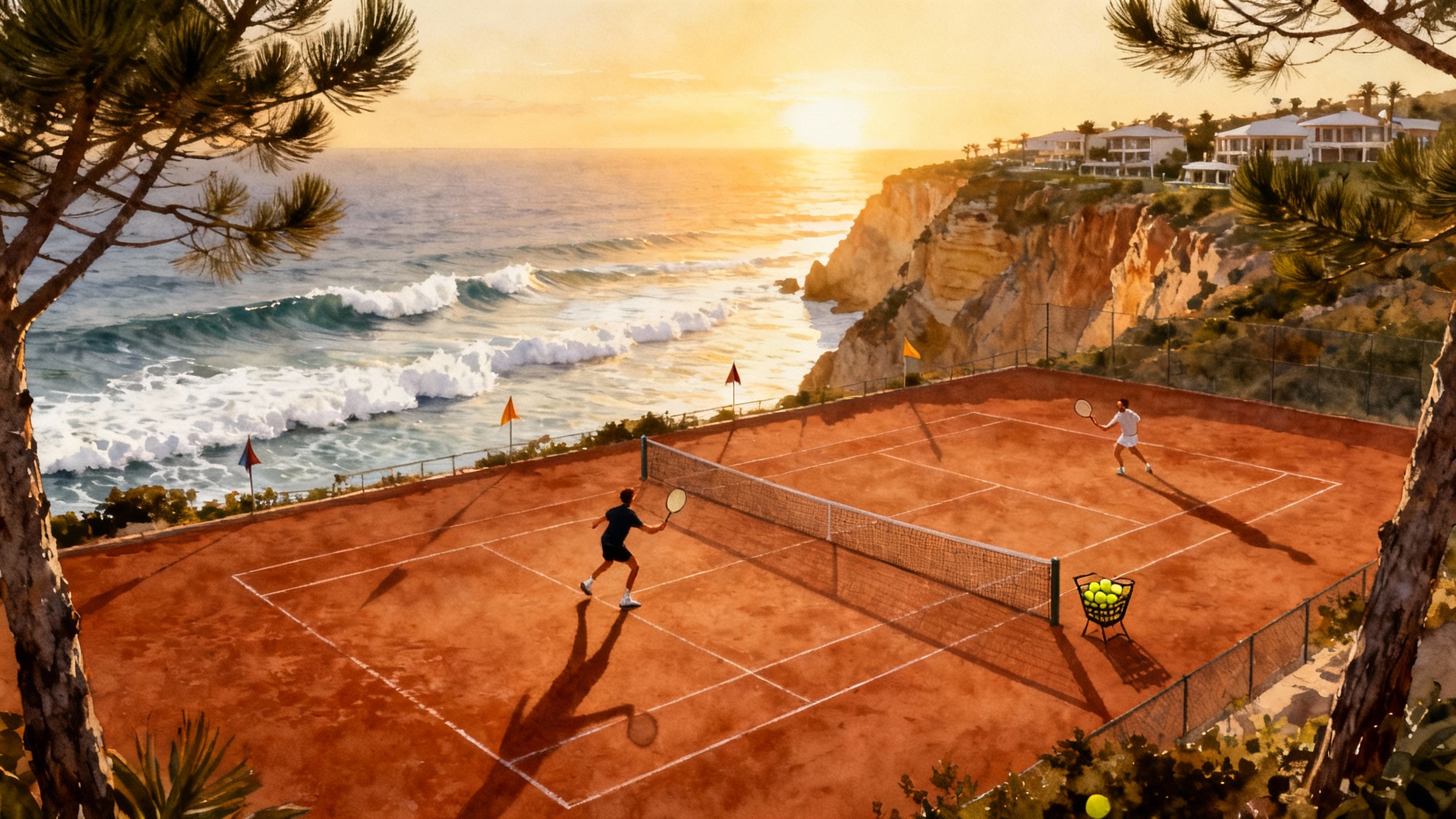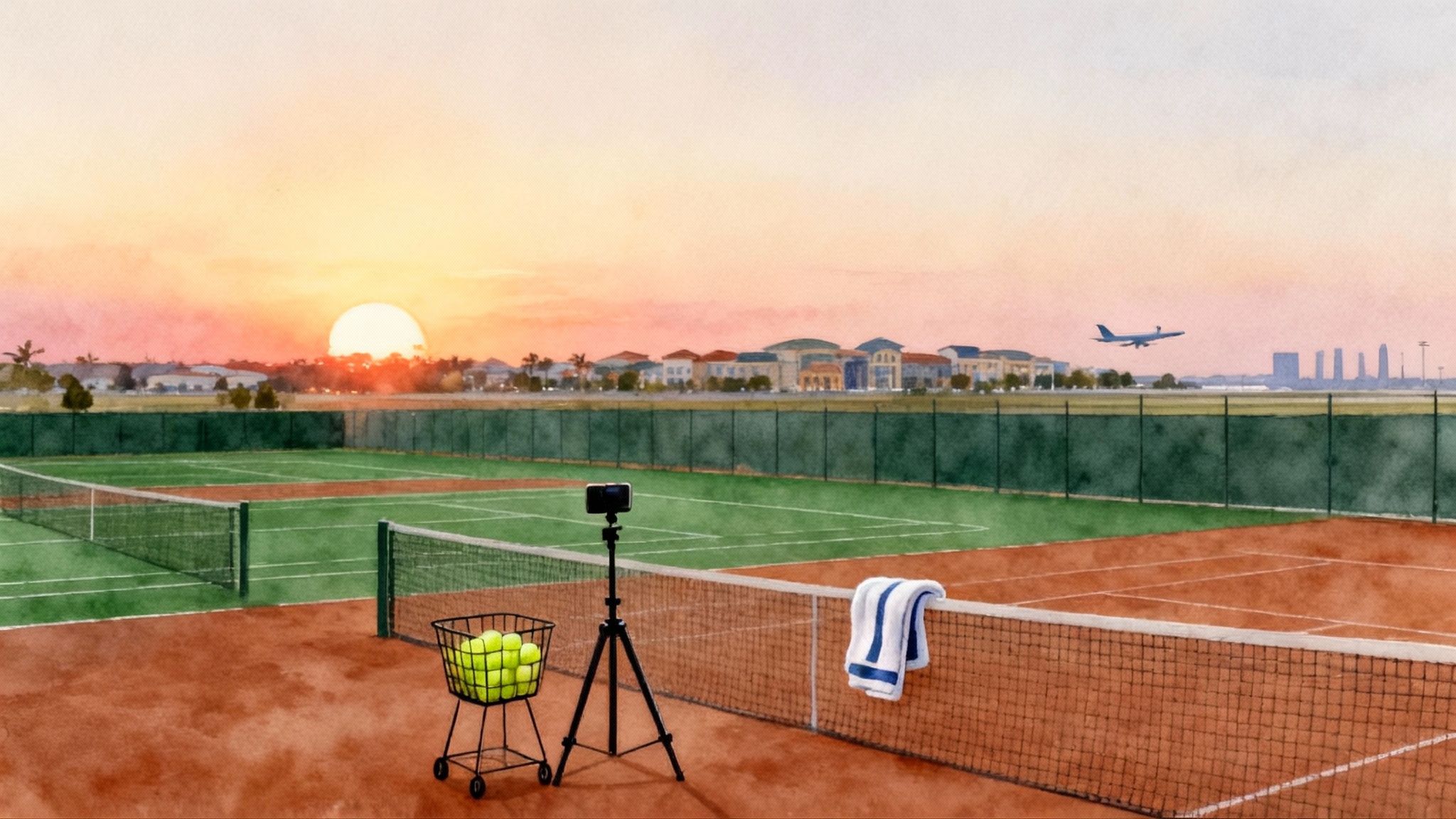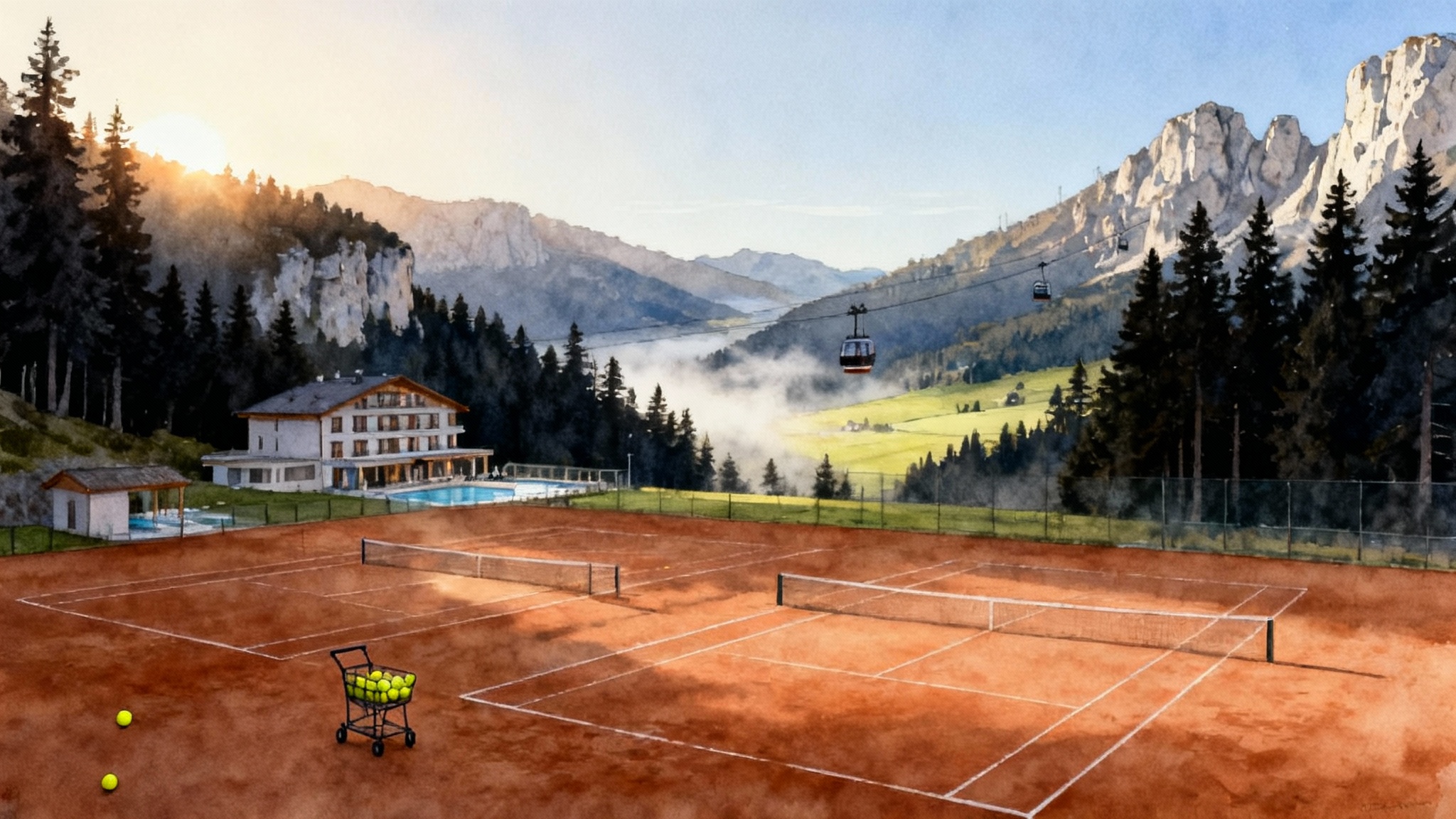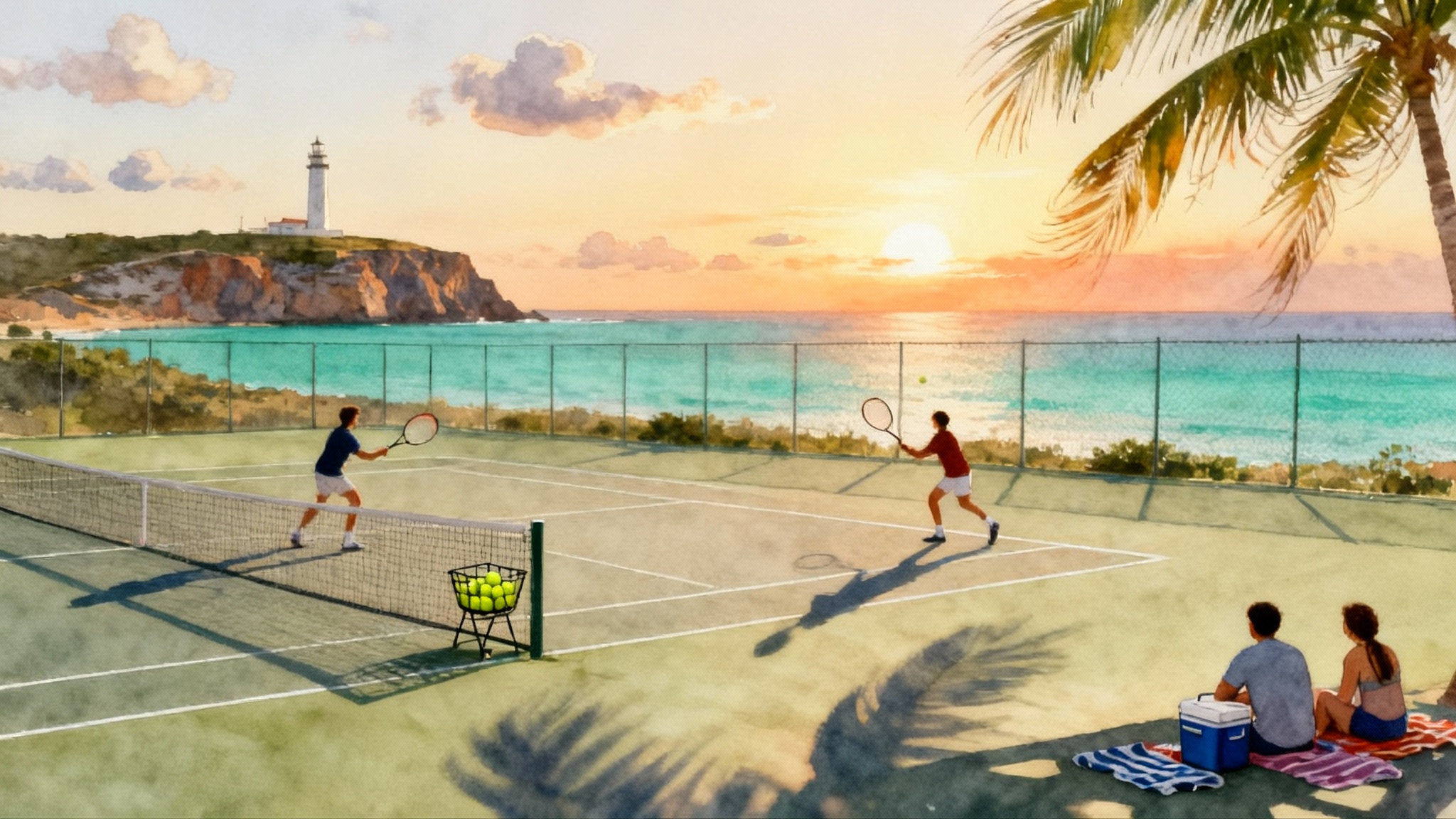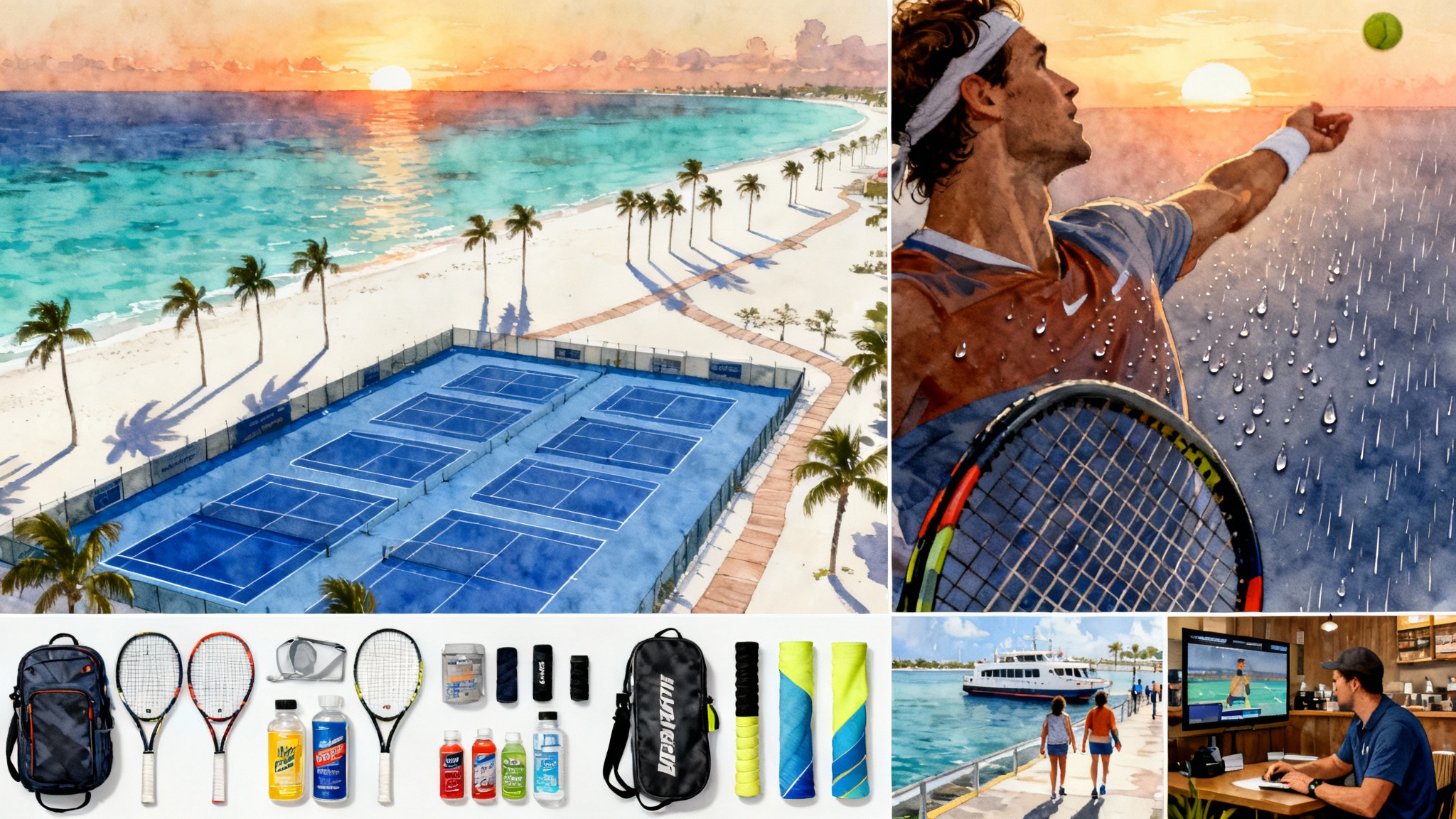South Florida Clay Corridor: Boca to Delray 7 to 10 Day Guide
Build a winter or spring Har-Tru block along the Boca Raton to Delray Beach corridor. Combine HIT Tennis Academy mornings, optional Boca West member access, and Delray match play with climate, recovery, and pro event strategies.
Why this corridor works for a Har-Tru block
Between Boca Raton, Deerfield Beach, and Delray Beach you can stitch together a compact, low-traffic training loop with three reliable anchors: morning high intensity at HIT Tennis Academy Deerfield, optional midday technical work if you have access at Boca West Racquet and Lifestyle, and afternoon match play at the Delray Beach Tennis Center. Drive times are short in non rush hour traffic, typically 10 to 25 minutes, which means more time on court and less time in the car. The surface is Har-Tru, the fast draining American green clay that rewards movement, point construction, and smart scheduling around heat and humidity.
If you plan this block between November and May you catch South Florida’s most stable tennis weather. For tennis travelers, that window reduces rain risk and keeps morning temperatures moderate. Tie your sessions to the pro calendar if you can. February brings Delray’s hometown tournament, and late March into April brings Miami’s biggest event, both a short drive away. See the Delray Beach Open schedule to align your week with stadium sessions and practice viewing.
For a central Florida hard-court contrast later in the season, consider this related plan: Lake Nona winter tennis week.
Climate windows and humidity acclimation
- Best months: November to May. Mornings are cooler and drier, with typical midday highs in the seventies to low eighties Fahrenheit earlier in the season and warmer by April. Rain is less frequent in winter. Summer is workable, but humidity spikes and pop up storms will shorten sessions.
- Time of day: Start early. A 7:30 a.m. warm up puts you in the best conditions and frees the afternoon for match play or ocean recovery.
- Three day acclimation: On days 1 to 3 keep morning volume at 70 to 80 percent of your home load. Use a conservative work to rest ratio, for example 1 minute on, 1 minute off in live ball drills, and add longer changeovers.
- Hydration and electrolytes: Pre load with 500 to 700 milliliters of fluids and 500 to 700 milligrams of sodium 90 minutes before training. During sessions, 150 to 250 milliliters every changeover is a good target for most athletes. If you sweat heavily or salt stains appear on your hat and shirt, increase sodium slightly.
- Sunscreen plan: Apply a broad spectrum 30 plus sunscreen 20 minutes before step one of the warm up, then reapply during a longer water break. Use a light long sleeve shirt and a breathable hat for afternoon matches.
The 7 to 10 day Har-Tru block
This template stacks high intensity mornings, technical tune ups, and competitive afternoons while leaving space for families, schoolwork, or beach time. Adjust court bookings and coaching to match your level and goals.
Morning high intensity at HIT Tennis Academy
- Time: 7:30 to 10:30 a.m.
- Focus: movement patterns for clay, live ball repetitions, and point patterns that force sliding entries and controlled deceleration. Expect ladders, cone work, two on one pressure drills, heavy cross patterns that finish with a line change, and serve plus one sequences.
- Why HIT first: The surfaces are tuned daily and crews manage clay moisture early. Your legs are freshest, and humidity is friendlier. Film one or two key patterns each day for feedback in the evening.
Midday recovery and optional Boca West member access
Boca West is a private club. Access typically requires membership or guest privileges through a member, resort stay, or a reciprocal arrangement. Confirm policies before your trip. If you do have access, use late morning or midday for lower intensity technical work.
- Time: 11:30 a.m. to 1:00 p.m.
- Focus: serves, returns, and set piece repetitions at lower volume. Try basket work on second serve kick and first ball patterns, then a short return plus one block. Keep intensity low and technical.
- If no access: book an extra half hour at HIT for serves after the morning block or use a public court for light shadow movement and targeted serves. Save your legs for afternoon matches.
Afternoon match play at Delray Beach Tennis Center
- Time: 3:30 to 6:00 p.m. when the sun softens.
- Format: two sets plus a 10 point match tiebreak if needed, or three short sets to four. Organize level based match ups and switch opponents daily.
- Surfaces: Har-Tru courts for your training goal and a few hard courts for contrast if your coach wants it.
- Tracking: use a simple scorecard for first serve percentage, return depth, and plus one execution. Keep a two column log after each set with one technical cue and one tactical cue.
Seven day plan
Day 1
- Morning at HIT: movement assessment, spacing on wide balls, neutral rally tolerance to nine balls. Keep RPE at 7 of 10.
- Midday: light mobility and a 20 minute swim. No second hit unless you already handle humidity well.
- Afternoon Delray: one set only, then 30 minutes of serve and return.
Day 2
- Morning at HIT: serve plus one patterns, ad and deuce court separately. Add second serve games to seven with serve targets and depth requirements.
- Midday: optional Boca West technical session if available. Otherwise nap and nutrition.
- Afternoon Delray: two sets. Work on defensive shape when pulled wide, then neutralize.
Day 3
- Morning at HIT: two on one side to side, then transition patterns with short approach footwork. Finish with down the line change after nine cross.
- Midday: beach walk in ankle deep water, 15 minutes each direction.
- Afternoon Delray: play someone who pushes you physically. Record first serve percentage and average rally length.
Day 4
- Morning at HIT: half volume day. Focus on returns and first four shots only.
- Midday: technique window at Boca West if accessible. Add 30 minutes of kick serve targets.
- Afternoon Delray: doubles for variety. Practice signals and poaching. Keep singles legs fresh.
Day 5
- Morning at HIT: heavy live ball. Simulate a qualifying draw with timed changeovers. Finish with a 10 minute fitness finisher.
- Midday: nap or simple stretching. No extra court time.
- Afternoon Delray: match against yesterday’s toughest opponent with one new tactical rule, for example every rally ball lands past the service line.
Day 6
- Morning at HIT: patterns into the forehand inside approach and controlled slide exits. Integrate drop shot plus lob response drills to exploit clay spacing.
- Midday: optional technical tune up, then a cold water ocean immersion for 5 to 8 minutes if you tolerate it.
- Afternoon Delray: two sets at full effort. Track return depth and net approaches.
Day 7
- Morning at HIT: test day. Two practice sets with coaching on changeovers and targeted serve games under scoreboard pressure.
- Midday: early dinner plan and travel packing.
- Afternoon Delray: lighter hit or doubles. End with a 30 minute cool down walk.
Add ons for a 10 day block
Days 8 to 10 keep the same rhythm but rotate opponents and add a hard court contrast day if you have spring hard court events coming. Use day 9 as a recovery plus video day, then finish day 10 with a test match.
Surface specific planning for Har-Tru
- Movement: think glide and brake. Enter with a controlled slide off the outside foot, then plant the inside foot to finish and recover. A poor slide is almost always a late decision problem. Build in three minutes of slide entries each warm up, for example shuffle shuffle slide plant recover.
- Patterns: long diagonals win time. Run nine ball cross before changing lines, especially on defense. When ahead in the score, create height with heavy spin and use drop shot only if the opponent’s first step is slow.
- Serve choices: use kick and slice for shape, not just pace. On ad court, serve body kick to wrong foot, then forehand inside pattern. On deuce court, slice wide to open the lane, then backhand up the line.
- Strings and balls: drop string tension by 2 to 3 pounds on clay to improve pocketing. Use regular duty felt on clay for better feel and less fuzz build up.
- Shoes and socks: clay court shoes have a herringbone tread that releases the surface. Bring two pairs of socks and a dry pair of shoes to change at lunch.
Beach recovery that actually works
South Florida’s ocean is an all day recovery tool. Use it on purpose.
- Morning walk: 20 minutes on firm sand with ankle to knee high water for light resistance. Keep a neutral foot strike to avoid calf overload.
- Ocean immersion: 5 to 8 minutes in the Atlantic for a gentle cold therapy effect. Do not exceed what you comfortably tolerate.
- Breath and posture: two slow nasal breaths per step on the walk calms the system and resets posture after a long match.
- Evening reset: five minutes of calf raises and tibialis raises on a step, then a short hip routine. This prevents next day stiffness that can make clay slides risky.
Where to stay and how to get around
Choose a base that keeps morning drives short and afternoons easy.
- Deerfield Beach oceanfront: ideal if you want quick access to HIT and the beach for recovery. Look for smaller hotels or vacation rentals within a few blocks of the pier.
- Boca Raton Mizner Park and Town Center: convenient to Boca West and a straight shot to Deerfield or Delray. Good food options within walking distance in Mizner Park.
- Delray Beach near Atlantic Avenue or Pineapple Grove: perfect if you want a lively evening walk after afternoon matches at the Tennis Center. Check parking rules if you rent a condo east of Federal Highway.
- Transportation: a compact rental car keeps parking easy at beaches and facilities. Rideshare works, but a car gives you control when afternoon storms require flexible start times.
- Drive times: Deerfield to HIT is minutes, Deerfield to Boca Raton 10 to 15 minutes, Deerfield to Delray Beach 20 to 25 minutes in non rush hours. Add buffer time on weekends and during festival days.
Fueling between sessions
- After morning HIT: 20 to 30 grams of protein and 60 to 80 grams of carbohydrate within one hour. Simple example is a yogurt and fruit bowl plus a granola bar.
- Pre match snack: 30 to 45 minutes before Delray matches, take 25 to 35 grams of easy carbohydrate and 250 milliliters of fluid.
- Evening refuel: aim for colorful vegetables and a starch that sits well for you. Avoid heavy fried meals before a big next day.
Families and serious player pathways
- For juniors: anchor schoolwork between 1:30 and 3:00 p.m., then head to match play. One parent can set up a shaded base with snacks and a hydration cooler. Rotate partners daily to keep motivation high.
- For college bound players: ask HIT for match charting templates and use them every afternoon. Capture serve direction, rally ball depth, and unforced errors by ball height. Review on video in the evening and convert three findings into next day drills.
- For adults: schedule one private technical tune up early in the block, one in the middle, and one on the last day. Use the middle session to check footwork spacing and slide exits on neutral balls.
Anchor your trip to the pros
If you can plan for February, build your week around the Delray event. Day sessions let you train in the morning, watch pros in the afternoon, and still get a light evening hit. Check the Delray Beach Open schedule for exact dates, day or night sessions, and practice court times.
If your trip lands in late March or early April, drive south to Miami Gardens for the combined event. Watching the best practice and play is a masterclass in court positioning and shot selection. Confirm dates and sessions through the Miami Open official dates.
Tip for families: practice courts are gold. Ten minutes of observing a top player’s serve routine can become your next day’s technical focus. Capture a few seconds of video and compare it to your own mechanics at lunch.
Packing list and logistics
- Racquets: travel with three if you are playing daily. Clay grime eats through overgrips faster than you think.
- Strings: one extra set per racquet for a 10 day block if you use thinner gauges.
- Shoes: one clay pair, one hard court pair for dry walk arounds, and a backup set of insoles.
- Hydration kit: two 1 liter bottles, electrolyte packets, and a small cooler. Freeze a bottle overnight to keep drinks cold at Delray.
- Sun kit: hat, sunglasses, sunscreen, and a lightweight long sleeve shirt for afternoons.
- Recovery: lacrosse ball, light resistance band, and a travel yoga mat.
- Admin: print or save booking confirmations for courts and coaching. Keep them in one folder on your phone for quick reference.
Sample budgets and booking checklist
Costs swing by season and options, but here is a planning frame for peak winter.
- Coaching and clinics: plan for daily morning clinics plus two or three private sessions across the block. Reserve at least two weeks ahead for holiday weeks.
- Courts: price differences exist between private club access and public bookings. If you play two hours daily for seven days, block the times early.
- Food and snacks: keeping a cooler saves money and time. Stock yogurt, fruit, wraps, and hydration mix from a grocery stop on day one.
- Transport: a compact car saves on parking and is easier around beach areas.
Checklist
- Reserve morning blocks at HIT, request video feedback if available.
- Confirm access arrangements or alternatives for Boca West.
- Book Delray Beach Tennis Center courts for afternoon matches in three day chunks.
- Decide on two pro sessions to attend if aligning with Delray or Miami.
- Share a training calendar with your travel group so everyone knows the plan.
A final word on mixing training and travel
This corridor rewards structure. Keep mornings fast and focused. Give the midday hours to recovery or light technical work. Protect the afternoon for competition and learning. Use the ocean to reset. Learn from the pros when they are in town. If you are traveling with family, a simple shared calendar and a cooler of snacks will transform a hectic week into a calm, repeatable rhythm.
A South Florida Har-Tru block is about layering gains. Small daily improvements in footwork and decision making on clay add up when you protect recovery and keep logistics tight. Plan with intention, slide with control, and you will leave Boca, Deerfield, and Delray with a stronger clay identity and a clearer path for the spring season.
